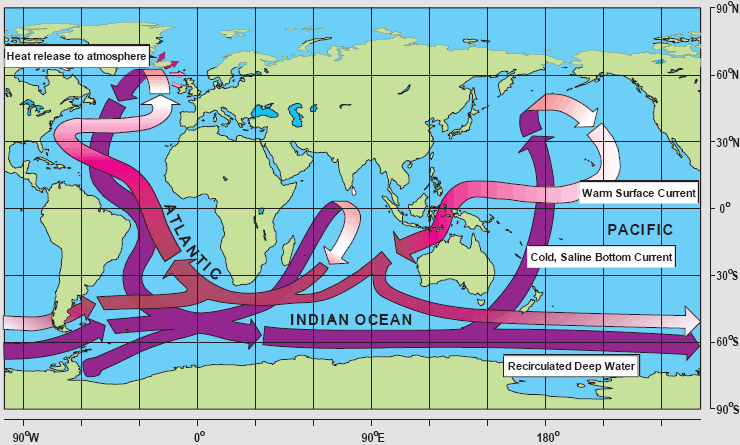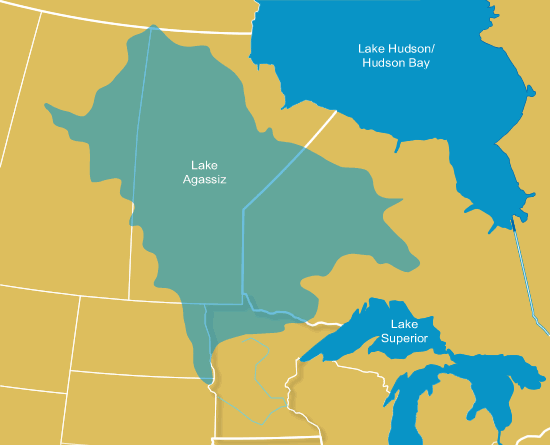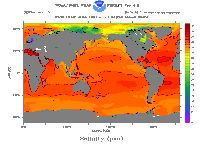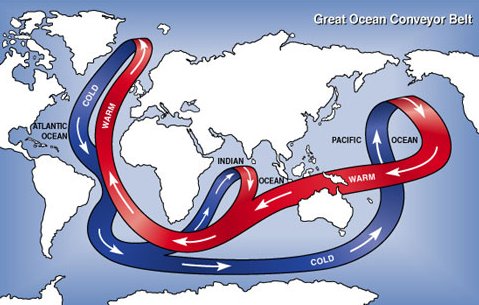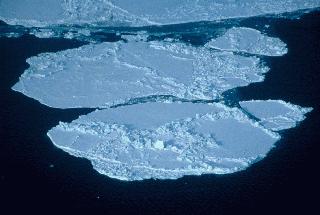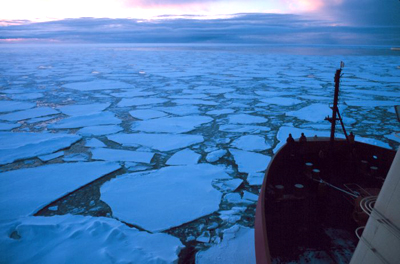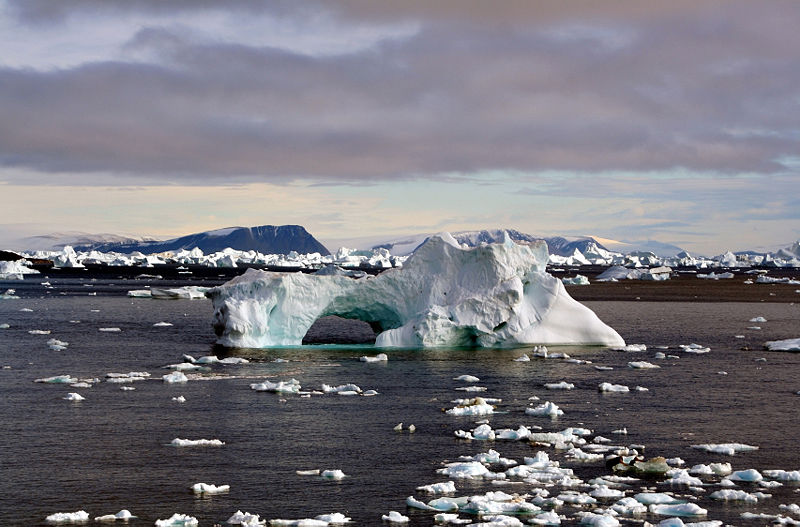Thermohaline Ocean Circulation
We've talked about a major ocean current system called the thermohaline circulation a bit already. Let's look at this phenomenon in a bit more depth, with an eye towards its potential implications for climate.
Cold water, in general, is denser than warm water. Likewise, water with a high salinity is denser than water that contains less salt. Surface ocean currents are primarily driven by winds. Deep ocean currents, on the other hand, are mainly a result of density differences.
The thermohaline circulation, often referred to as the ocean's "conveyor belt", links major surface and deep water currents in the Atlantic, Indian, Pacific, and Southern Oceans. Let's follow this current around the globe, noting the forces that drive it.
Multiple mechanisms conspire to increase the density of surface waters at high latitudes. Cold winds blowing over the oceans chill the waters beneath them. These winds also increase evaporation rates, further removing heat from the water. These chilled waters have increased densities, and thus tend to sink. Formation of sea ice also helps to increase the density of water near Earth's poles. As sea water freezes, salt is forced out of the ice in a process called "brine exclusion". Sea ice is, surprisingly, essentially fresh water! The excluded salt increases the salinity of the cold water immediately below the ice, making it denser still. The salty, cold water near the poles sinks toward the ocean floor.
The thermohaline circulation "conveyor belt". Purple arrows indicate cold, deep ocean currents. Red arrows show shallow, warm water circulation patterns. |
Just as rivers on land flow downhill towards the sea, deep density-driven currents in the oceans move along submarine valleys towards the deepest parts of the ocean. The cold, salty waters that drive the thermohaline circulation form in the Arctic Ocean, the North Atlantic, and the Southern Ocean. The shallow ocean floor along the Bering Straight prevents deep currents from flowing out of the Arctic Ocean into the Pacific. Dense water on the floor of the North Atlantic moves southward, eventually joining the sinking waters of Southern Ocean in the far South Atlantic. Once again, a shallow section of the ocean floor blocks the flow from moving into the Pacific. In this case the Drake Passage, between the Antarctic Peninsula and the southern tip of South America, prevents the current from flowing westward. So the thermohaline circulation turns to the east. Here the current splits; some flows northward along the east coast of Africa into the Indian Ocean, while the rest continues eastward along the southern coast of Australia and finally, veering northward, makes it into the vast Pacific basin.
|
This video provides a guided tour of the thermohaline circulation system. |
At this point the two branches of the thermohaline circulation finally begin to mix with the lighter, warmer waters above and work their way back to the surface. Scientists estimate that the trip from the North Atlantic to the deep water upwelling sites in the Pacific takes about 1,600 years. To balance the flow of deep water into the Indian and Pacific basins, surface water must flow back out. Warm surface waters from the Pacific flow through the Indonesian Archipelago into the Indian Ocean, where they join with other currents that have risen from the depths. This combined flow works its way westward around the southern tip of Africa into the South Atlantic. Next, the surface flow moves northward through the Atlantic. Aided by a nudge from the warm Gulf Stream surface current, this water makes its way once again to the extreme North Atlantic, where the cycle begins again. This global circulation pattern mixes the waters of the world's oceans, turning the ocean reservoirs into a single, vast, interconnected system.
Thermohaline Circulation Implications for Climate
The thermohaline circulation has a tremendous influence on Earth's climate and has implications for both likely and possible directions for climate change.
The thermohaline circulation plays an important role in supplying heat to the polar regions. Therefore, it influences the rate of sea ice formation near the poles, which in turn affects other aspects of the climate system (such as the albedo, and thus solar heating, at high latitudes).
Water's long trip through the ocean's depths on the great ocean conveyor belt, far from surface water influences and contact with the atmosphere, contributes to the a lag time between climate forcings and our planet's reactions to them. Heat and dissolved carbon dioxide, carried to the oceans depths by the thermohaline circulation, may remain "buried" in the abyss for centuries. This "burial" may forestall initial effects of global climate change; but like zombies in a horror flick, may come back to haunt us much later when they arise from the depths.
The Younger Dryas - A Warning from the Past?
About 12,000 years ago, as the Earth was beginning to warm near the end of the Wisconsin glacial, a tremendous cold spell gripped the high latitude regions of the Northern Hemisphere. For roughly 1,300 years at least some northern regions returned to peak ice age conditions. The onset of this return to frigid conditions was relatively sudden; the transition apparently occurred within a century or less. This sudden return to extremely cold conditions is known as the Younger Dryas, after the vast quantities of pollen from tundra flower species, Dryas octopetala, found in sediment cores associated with that time period. There was also and older, less dramatic cooling event known as the Older Dryas.
A deluge of fresh water from glacial Lake Agassiz, flowing into the North Atlantic via the Great Lakes and the St. Lawrence Seaway, may have triggered the Younger Dryas event. |
Scientists are not sure exactly how widespread the Younger Dryas was; whether it was an event of global or more regional scale. They are not entirely certain about the cause or causes of the Younger Dryas, either. However, many scientists believe a partial or total shutdown of the thermohaline circulation may have been involved; and that we would be wise to heed this as a warning of one potential fate that may befall us as a result of global climate change.
As the vast North American ice sheets began to melt towards the end of the Wisconsin glacial, a huge lake formed from the meltwater in what is now central Canada. Some scientists believe that the Younger Dryas was triggered when a huge flood of water from Lake Agassiz burst forth, suddenly dumping a large supply of fresh water into the North Atlantic. According to this theory, the influx of fresh water shut down the normal cycle of the thermohaline circulation, effectively turning off that current system in a very short time. As we've mentioned, the thermohaline circulation brings warm, tropical waters northward towards the Arctic and sends cold, polar waters southward. A disruption of this flow would dramatically alter regional, and possibly even global, patterns of heat transfer. The theory claims that this shutdown temporarily plunged at least some parts of the Northern Hemisphere back into peak "ice age" conditions. Eventually, the flow from Lake Agassiz subsided, and the thermohaline circulation re-established itself.
Some scientist believe a repeat performance of this event, more or less, could happen in the future. Continued rapid melting of Arctic sea ice, combined with extensive melting of the Greenland ice sheet, would inject a lot of fresh water into the North Atlantic. This is a path which continued global warming might lead us down. Could such an infusion be large enough and rapid enough to shut down, or at least disrupt, the thermohaline circulation? Nobody knows for sure. Most scientists believe this is a "low probability, but high consequence" scenario. Some think that the Younger Dryas event should serve as a cautionary tale; that not all climate change is gradual, and that a series of unlikely events can sometimes be strung together to produce catastrophic changes.


